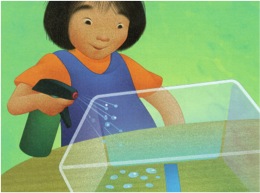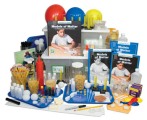Posts tagged ‘elementary school science’
Scientific Evidence and Secrets of the Stomach: A Fun Lesson for Students
 To uncover a secret, scientists look for evidence. Long ago, scientists investigated to find out how the stomach works. The scientists did some surprising things. One investigated digestion by collecting stomach juices from a man with a hole leading to his stomach! The scientists did all of these things to find evidence about how the stomach breaks down food.
To uncover a secret, scientists look for evidence. Long ago, scientists investigated to find out how the stomach works. The scientists did some surprising things. One investigated digestion by collecting stomach juices from a man with a hole leading to his stomach! The scientists did all of these things to find evidence about how the stomach breaks down food.
In the Seeds of Science/Roots of Reading® student book Secrets of the Stomach, the work of three scientists who investigated how the stomach digests food is described. It outlines how each of them found evidence that added to the scientific community’s understanding of digestion. By sharing one of the investigations from this book, you can help students learn that scientists base their explanations on evidence. After hearing the story, students learn that acid juices in the stomach aid in the digestion of food.
Students learn:
- Science investigations begin with a question.
- The stomach is a bag-like structure that holds food.
- The stomach mixes food up and breaks it down with acid.
Beaumont Gets the Inside Story
Share this amazing story with your students. They will be fascinated to hear of a man who had
Forms of Energy: Everyday Examples to Help Students
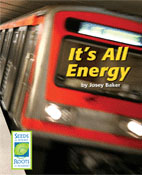 Help students understand energy and its various forms with everyday examples. Students can learn about electrical, motion, sound, thermal, light, and chemical energy with the situations and processes they experience in everyday life. You can finish the lesson with a printable student sheet that reinforces what the students have learned.
Help students understand energy and its various forms with everyday examples. Students can learn about electrical, motion, sound, thermal, light, and chemical energy with the situations and processes they experience in everyday life. You can finish the lesson with a printable student sheet that reinforces what the students have learned.
In the Seeds of Science/Roots of Reading® book It’s All Energy, students read about the many different forms of energy we use every day—to move, talk, cook, create music, light or heat. Below are some examples form the book that you can use with your class to help them understand various forms of energy. Start with a brief description of energy.
What Is Energy?
Energy makes things happen. Every time something moves, it is because of energy. Every time something gets warmer, it is because of energy. Every time something makes a noise, it is because of energy. People use energy to talk, run, and think. In fact, every time we do anything, we use energy!
There are different forms of energy:
- electrical
- motion
- sound
- thermal
- light
- chemical
Electrical Energy
A bolt of lightening is electrical energy. This is the same kind energy used by (more…)
Systems: Teach Students How Parts Interact to Create a Whole
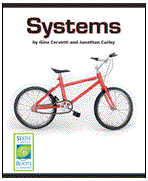 A bicycle is an example of a system that students can think about to understand the the meaning of the words function and system. The information provided below gives students an overview of a system as it relates to a bicycle. Students can then use the Daily Written Reflection worksheet to reinforce what they’ve learned. This worksheet is used as part of the Seeds of Science/Roots of Reading® unit Digestion and Body Systems which uses a student book called Systems. The activity below provides the content you need from this unit to bring this activity into your classroom.
A bicycle is an example of a system that students can think about to understand the the meaning of the words function and system. The information provided below gives students an overview of a system as it relates to a bicycle. Students can then use the Daily Written Reflection worksheet to reinforce what they’ve learned. This worksheet is used as part of the Seeds of Science/Roots of Reading® unit Digestion and Body Systems which uses a student book called Systems. The activity below provides the content you need from this unit to bring this activity into your classroom.
What Makes a Wheel a Wheel
Think about a bicycle wheel. Have you ever thought about why a wheel is the way it is? It’s the structure of a wheel – the way the wheel is shaped and built – that makes it a wheel. The wheel is long and has long, thin spokes crossing in the middle. The spokes keep the wheel from bending out of shape.
Why is the structure of the wheel important? Its structure has to do with its function – what it does or what it is used for. The function of this wheel is to roll so that the bicycle can move forward. What if the wheel had a different structure. Could it still do its function? Could the wheel roll if it were shaped like a square? What if the wheel were floppy like a noodle?
A Wheel Is Just One Part of a Bicycle.
A bicycle is made up of lots of parts. One bike could have more than 100 different parts. Each part of a bicycle has a function and a structure that helps the part perform its function well. Of course, bike parts don’t do much good unless they are all put together to make a bicycle. You can’t ride just a wheel! A bicycle with all its parts connected is a system.
A system is a group of parts that interact, or work together. When the pedals on a bicycle move, they turn the gear. When the gear turns, it moves (more…)
Introduce Students to Concepts About Shorelines and Beaches
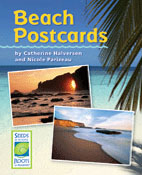 Most students have heard the terms “beach” and “shoreline,” but do they know the difference?
Most students have heard the terms “beach” and “shoreline,” but do they know the difference?
Here are some important concepts for students:
- a shoreline is a place where water meets land
- a beach is a shoreline where people can walk near the water
- beaches are covered with loose material
- beaches can be rocky, sandy, or covered with coral or beach wrack
In the Seeds of Science/Roots of Reading® book Beach Postcards, students can read an account of a girl named Jo, who visits beaches around the world with her family, and sends postcards back to her friend Linn. Linn writes a report about what she learned about beaches and shorelines from Jo’s postcard. In addition to conveying the concepts bulleted above, the book is also designed to help students who may have limited knowledge of shorelines to imagine the experience of being at various beaches.
Below are some questions you can pose using content taken from the book.
How is a beach different from some kinds of shorelines?
Explain that the place where water meets the land is called a shoreline. There are many kinds of shorelines all around the world.
Beaches are one kind of shoreline. Beaches are shorelines where people can walk beside the water. Beaches are covered with loose material like rocks or sand. Beaches can form along lakes, rivers, and the ocean.
What do you think you would see if you were standing on a rocky beach? What would you feel? What would you wear to visit this beach?
Explain that rocky beaches are covered with rocks and pebbles. Some of the rocks are big. The pebbles are small.
Rocks and pebbles get to the beach in many ways. Rocks can fall onto the beach from cliffs. Rocks on the beach can break and become pebbles. Rocks and pebbles can be carried to the beach by waves or rivers. There may be (more…)
Help Students Model the Process of an Investigation
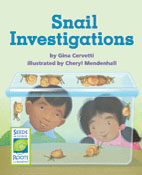 Students can follow the same steps a scientist takes during an investigation. An investigation is considered to be any formal effort to inquire about something. Investigations include all of the various ways that scientists find out about the world: experiments; systematic observations; making and testing a model; summarizing what others have learned from research papers, articles, or books; etc. People often misrepresent the ways that scientists investigate by calling everything a scientists does an experiment. Actually, an experiment is a very specific kind of investigation, involving a comparison between two situations that are alike in all ways but one.
Students can follow the same steps a scientist takes during an investigation. An investigation is considered to be any formal effort to inquire about something. Investigations include all of the various ways that scientists find out about the world: experiments; systematic observations; making and testing a model; summarizing what others have learned from research papers, articles, or books; etc. People often misrepresent the ways that scientists investigate by calling everything a scientists does an experiment. Actually, an experiment is a very specific kind of investigation, involving a comparison between two situations that are alike in all ways but one.
In the Seeds of Science/Roots of Reading® student book Snail Investigations, a story models the process of conducting an investigation – ask a question, investigate, record observations, make an explanation based on evidence, and ask a new question. Below is a sample section from the book to show how a student conducts an investigation with snails. You can share this with your students, discuss the investigation process and problems encountered by the student in the book. Make note of bolded words which can be highlighted as important science vocabulary terms.
Students learn:
- it is possible to investigate to find answers to questions
- scientific investigations involve a series of steps
- scientists often encounter unexpected problems as they investigate and have to think of new ways to answer questions
- it is important to make a careful record of one’s observations, and there are many different ways to do so
Investigating what makes a good snail habitat.
How much moisture do snails need?
Hope’s question was, “How much moisture do snails need in their habitat?” She wondered whether a wet or dry habitat is better for snails.
Hope sprayed a little water on half of her terrarium floor. That half of the floor became very moist. She was careful to keep the other half of the floor dry.
Hope put seven snails in a line on the terrarium floor, between the wet half and the dry half. She got out her notebook to record where they went.
Hope observed her snails’ behavior. Six snails climbed to the terrarium lid. The seventh snail didn’t move at all.
Hope was not sure what to think. She expected the snails to choose either the wet half or the dry half of the terrarium floor. But most did not choose either one. They climbed to the lid instead. She did not have enough evidence to answer her question. How could she find out how much moisture snails need? She wondered if climbing up is just what snails do.
Next Hope read a book about snails. She learned that snails do often climb on rocks, twigs, and walls. Hope decided to observe more snails. She placed 22 snails in a dry, empty terrarium. When Hope checked an hour later, she found only two snails ob the bottom. Ten snails were on the sides and ten were on the top.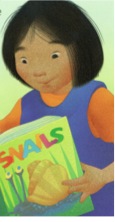
Hope still did not know which is better for snails, a wet habitat or a dry habitat. But she did find out something about how snails behave.
Hope knew she would need to find a different way to investigate her question, “How much moisture do snails need?”
At this point, you can ask your students how they would investigate Hope’s question. To record their investigation, they could create a table that allows them to make note of each step’s results.
Step 1: Ask a question
Step 2: Investigate
Step 3: Record observation
Step 4: Make an explanation based on evidence
Step 5: Ask a new question
To reinforce the process, have the students retell what happened in Hope’s investigation and fill out the table as if it were their investigation.
Reinforce concept of what it means to investigate
Ask, “What have we learned about what it means to investigate?” Accept several responses. Tell students that investigating is an important part of what scientists do, so it’s important that we really understand what it means to investigate. Read the following sentences: “There are many ways to investigate your question. You can observe. You can read. You can ask an expert.”
Ask, “What does investigate mean?” Accept several responses. Tell students that investigate means to search for evidence to try to learn more about something. Usually when we investigate, we follow a series of steps to try and answer a question. When scientists want to answer questions about the world, they investigate. Scientists investigate many things, including how to cure diseases, how to help plants grow, and what animals live in the rain forest.
For more information about the student book Snail Investigations and the Soil Habitats science and literacy unit, visit http://www.scienceandliteracy.org.
Do you want to be notified when we publish new blog articles? Simply enter your email address in the “Follow Blog via Email” box located in the right sidebar.
Earthworms Help Students Understand Habitat and Adaptation
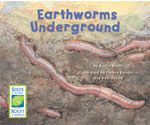 Earthworms have different structures and behaviors that help them survive in their underground habitat. These adaptations are intriguing to students who wonder things such as:
Earthworms have different structures and behaviors that help them survive in their underground habitat. These adaptations are intriguing to students who wonder things such as:
- How do earthworms breathe underground?
- How do earthworms move around?
- What do earthworms eat?
- How do earthworms protect themselves from danger?
These questions are answered in the Seeds of Science/Roots of Reading® book Earthworms Underground. You’ll find the details below. In addition, we’ve suggested an activity that will help reinforce key concepts you’ve presented to your students.
How do earthworms breathe underground?
When people breathe, you see their bellies moving in and out. You won’t see that in an earthworm. To breathe, an earthworm absorbs air through its skin. An animal that breathes through its skin needs moisture. If the animal’s skin dries out, it can’t absorb air. An earthworm’s habitat is soil with lots of moisture. The earthworm can breathe there.
How do earthworms move around?
Many animals move with their legs. But earthworms don’t have legs! Legs would get in the way in earthworms’ tiny underground burrow. Earthworms have different adaptations for moving through the soil. Earthworm bodies are made of segments. Each segment has tiny hairs on it. View the illustration below to see how the segments and tiny hairs work with the movement process of earthworms.
What do earthworms eat?
Earthworms eat soil and the dead and living organisms in the soil. Sometimes you can see all this stuff moving through an earthworm’s body. Earthworms dig through the soil as they eat. The burrows they dig can last a long time. Earthworms use the burrows to get from place to place.
Because it eats dead organisms, an earthworm is called a decomposer. It breaks down dead things into soil. Sometimes when it’s wet and dark outside, earthworms go above ground. They find small dead organisms, like leaves and beetles, and pull them underground to eat.
How do earthworms protect themselves from danger?
Living underground protects earthworms from many predators, but not all of them. Some predators, like moles, live underground, too. Moles are small, furry animals with tiny eyes. Their front legs are shaped for digging. When a mole comes near, earthworms can feel the soil shaking. They move quickly to get away.
Birds are also predators of earthworms. Some birds stand on the ground and listen for earthworms moving under them. The birds try to pull earthworms out of their burrows. Earthworms hold on to the soil with their tiny hairs. Sometimes the bird eats the whole earthworm. But earthworms have a strange adaptation to protect themselves.
If a bird pulls on an earthworm’s tail end, sometimes it breaks off. The bird is left with just a piece of tail. The piece keeps moving, and the bird may think it has the whole earthworm. If only a little bit of the tail breaks off, the earthworm can move away and survive. Later, the tail grows back.
Reinforce concepts with pictorial representations
After you’ve used the information above to explain an earthworm’s habitat and adaptation to your students, have some volunteers make pictorial representations of the key concepts on a concept wall. Give each small group one of the key concepts and ask them to create a drawing to represent the concept. Tell them that, first, they will need to decide as a small group what they would like to draw. Then distribute drawing paper and crayons to each small group.
For more information about the student book Earthworms Underground and the Soil Habitats science and literacy unit, visit http://www.scienceandliteracy.org.
Do you want to be notified when we publish new blog articles? Simply enter your email address in the “Follow Blog via Email” box located in the right sidebar.
Mystery Forces: A Fun Way for Students to Distinguish Between Forces
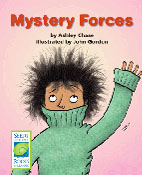 Help students understand that gravity and other forces are at work all around us. Forces can make objects float in the air, stick together, and do other strange things. In the Seeds of Science/Roots of Reading® book Mystery Forces, students read about strange things that happen because of forces. They try to figure out which force is at work in each story. Is the mystery force gravity, magnetic force or electrostatic force?
Help students understand that gravity and other forces are at work all around us. Forces can make objects float in the air, stick together, and do other strange things. In the Seeds of Science/Roots of Reading® book Mystery Forces, students read about strange things that happen because of forces. They try to figure out which force is at work in each story. Is the mystery force gravity, magnetic force or electrostatic force?
Below are some examples you can use with your class, along with a chart that will help them distinguish between the forces. They can refer to this chart when deciding which force is the culprit.
Case of the Moving Spoon
A magician is sitting at a table. She stares at a metal spoon and it slides across the table. You ask her to move a glass. She says her magic only works on metal objects.
How can the magician move the spoon without touching it? Why does her magic only work on metal objects?
What force is at work here? What evidence of the force can you find? What is pushing or pulling on what?
Explanation: In the case of the moving spoon, the mystery force is magnetic force. The magician has a strong magnet under the table. Even through the table, the magnet attracts the metal spoon. When the magician moves the magnet, the spoon moves with it. She can only move metal objects because magnets pull strongly on some kinds of metal. Magnets don’t attract glass or other materials.
Case of the Shrinking Apple Tree
The apple tree in the park used to be taller than the swing set. This summer, lots of apples are growing on the tree. The branches are hanging down. Now the tree is shorter than the swing set!
Trees usually grow bigger. Why is this tree shrinking?
What force is at work here? What evidence of that force can you find? What is pushing or pulling on what?
Explanation: In the case of the shrinking apple tree, the mystery force is gravity. Earth is pulling the heavy apples down with the force of gravity. The branches aren’t strong enough to hold so many apples up. That’s why they are hanging down. With the branches hanging down, the tree is shorter than it usually is.
Case of the Sticky Socks
You pull two clean socks out of the dryer. The socks are stuck together. Why did the socks stick together?
What force is at work here? What evidence of that force can you find? What is pushing or pulling on what?

Explanation: In the case of the sticky socks, the mystery force is electrostatic force. When the socks rolled around in the dryer, they rubbed against other clothes. One sock became charged. The socks are attracting each other.
Forces Chart
Extending the lesson
Explain to students that, in addition to the situations above, mystery forces are all around them all the time. Tell them to be a force detective at home. They can look around for evidence of magnetic force, gravity, and electrostatic force. Their challenge is to figure out which force is at work when they see someone’s hair sticking up or leaves falling from a tree. They can share their stories with classmates and compare experiences of finding mystery forces everywhere!
For more information about the student book Mystery Forces and the Gravity and Magnetism science and literacy unit, visit http://www.scienceandliteracy.org.
Do you want to be notified when we publish new blog articles? Simply enter your email address in the “Follow Blog via Email” box located in the right sidebar.
Students Can Celebrate National Walking Day with a “Walk in the Woods”
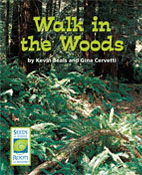 April 3, 2013 is National Walking Day. The day was created to raise awareness of the importance of physical activity. One type of physical activity that can be a learning experience for students is a walk in the woods. When students walk in the woods, they notice lots of things. In the Seeds of Science/Roots of Reading® book Walk in the Woods, students “accompany” a soil scientist named Asmeret as she walks through the woods. Students see the world through a soil scientist’s eyes as Asmeret searches for evidence of decomposition. As Asmeret guides students through the forest, several important ideas emerge: soil is made of living and non-living things; small organisms help decompose dead plants and animals; and through decomposition, soil is made. It shows how scientists look for evidence to help answer questions about the world.
April 3, 2013 is National Walking Day. The day was created to raise awareness of the importance of physical activity. One type of physical activity that can be a learning experience for students is a walk in the woods. When students walk in the woods, they notice lots of things. In the Seeds of Science/Roots of Reading® book Walk in the Woods, students “accompany” a soil scientist named Asmeret as she walks through the woods. Students see the world through a soil scientist’s eyes as Asmeret searches for evidence of decomposition. As Asmeret guides students through the forest, several important ideas emerge: soil is made of living and non-living things; small organisms help decompose dead plants and animals; and through decomposition, soil is made. It shows how scientists look for evidence to help answer questions about the world.
Students might be amazed to learn that everything in the woods could become part of the soil. The rocks, the leaves and wood, and even the animals could become soil someday. When organisms decompose, they make rich soil. Rich soil has lots of nutrients. Plants need these nutrients to grow,
Students can witness decomposition if they look closely. Trees show evidence of decomposition.
Leaves also show signs of decomposition.
Students may ask how dead plants and animals become soil. The answer may sound strange, but other organisms make them into soil. These organisms are called decomposers. Decomposers break dead things down into soil. They add nutrients to the soil. Here are a few examples of decomposers.
Everything that is living will die one day. Decomposers will break it all down into soil. Now that students understand the important role of decomposers, it may be hard for them to imagine a forest without them. How soil is created may just be one of the questions students have during a walk in the woods. As they find new things, they may be encouraged to research the answers to their questions. They are then acting like scientists. We hope they get their hands dirty and investigate!
For more information about the student book Walk in the Woods and the Soil Habitats science and literacy unit, visit http://www.scienceandliteracy.org.
Do you want to be notified when we publish new blog articles? Simply enter your email address in the “Follow Blog via Email” box located in the right sidebar.
Ecosystem Awareness for Students: A Visit to a Pond
Ponds may look peaceful, but they are full of buzzing, swimming, creeping life. Some ponds are half the size of a soccer field and you could walk the perimeter in a matter of minutes. However, close observations can reveal a fascinating world of organisms. All living organisms need water. Plants grow where there is water, and animals tend to live around plants. This is why a visit to a pond can be an engaging activity for students. Below is information you can provide to students about what they might see on a walk around a typical pond.
 In the Seeds of Science/Roots of Reading® student book Visit to a Pond, many of the environmental factors about ponds are described (where the water comes from, how much sunlight it gets) as well as many of the typical members of a pond community (birds, visiting mammals, insects, turtles, and fish). This book is particularly useful for students who may not live near a pond. It can also answer questions and reinforce concepts for students who have explored a pond in person.
In the Seeds of Science/Roots of Reading® student book Visit to a Pond, many of the environmental factors about ponds are described (where the water comes from, how much sunlight it gets) as well as many of the typical members of a pond community (birds, visiting mammals, insects, turtles, and fish). This book is particularly useful for students who may not live near a pond. It can also answer questions and reinforce concepts for students who have explored a pond in person.
Decomposing
Edges of the pond often muddy, usually as a result of rain. Leaves can be observed decomposing in the mud, slowly turning into dirt. Decompose means to break down into smaller and smaller parts.
Evidence
Students might use evidence to determine what took place in and around a pond. In the photograph below, they can see the muddy dirt trail is covered in animal tracks. They look like handprints from the paws of a raccoon. Raccoons are mostly active at night. During the day, these tracks are the only evidence that raccoons have been here. Evidence are clues that help explain or answer a questions.
Predator
Floating near the surface are aquatic plants that don’t need soil. Many small animals in the pond use aquatic plants as food and shelter. Pond snails crawl along plants underwater, eating the plants as they go. The plants also give the snails a safe place to hide from predators. A predator is an animal that hunts and kills other animals.
Prey
Students might catch a glimpse of a frog floating at the surface of the water where it can breathe air while waiting for prey. If an insect comes too close, it may be caught by the frog’s long, sticky tongue. Prey is an animal that is hunted and eaten for food.
Pond organisms
If they’re lucky, students might catch a glimpse of one or more of the following organisms while visiting a pond. These are also featured in student book Visit to a Pond.
- Dragonflies
- Ducks
- Kingfishers
- Fish
- Water striders
- Turtles
- Great blue herons
- Snakes
- Water boatman
While a pond may seem calm, it is rich and full of life. There is a world of constant motion – of eat and be eaten, of swim and fly, of creep and crawl. We encourage you and your students to take the time to pay close attention so you’ll begin to see organisms and notice patterns.
For more information about the student book Visit to a Pond and the Aquatic Ecosystems science and literacy unit, visit http://www.scienceandliteracy.org.
Do you want to be notified when we publish new blog articles? Simply enter your email address in the “Follow Blog via Email” box located in the right sidebar.
6 Tips for Students. Communicating the Results of an Investigation.
One of the most important things scientists do is communicate. They share explanations of what that have learned with the scientific community – scientists all over the world. When scientists have explanations to share, they often write reports for scientific journals. Scientists also communicate with one another in person at conferences. They share their data and explanations by giving speeches in front of big groups and/or by presenting posters. This communication helps scientists learn from other scientists’ investigations. When one scientist answers a question, this helps other scientists investigate their own questions.
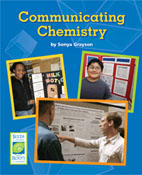 In the Seeds of Science/Roots of Reading® student book Communicating Chemistry, students can read about a chemist who makes a poster and presents it at a conference. Reading about his experience will provide tips for students who want to share the results of their own scientific investigations.
In the Seeds of Science/Roots of Reading® student book Communicating Chemistry, students can read about a chemist who makes a poster and presents it at a conference. Reading about his experience will provide tips for students who want to share the results of their own scientific investigations.
Here are 6 helpful tips for students presenting a poster:
- Think about your audience. Make sure that someone who doesn’t already know all about your investigation will be able to understand what you did and what you found out.
- Keep it simple. A poster should be about what you were investigating, how you did it, and what you learned.
- Before you present, try to think of questions that people might ask you. Have answers to these questions in mind.
- When talking about your investigation, try to make just a few main points. You don’t need to talk about everything that happened.
- Be sure to speak slowly and clearly.
- Practicing your presentation out loud will help you figure out what to say. If you have practiced, presenting will be easier on the big day.
By presenting their ideas, students act as scientists who bring the community one step closer to answering the big questions. The big discoveries in science almost always grow out of work that many scientists have been doing over many years. That’s because big questions can be hard to investigate. Scientists break big questions down into smaller questions that are easier to investigate.
Students can read about Michael Grass, a chemist who presents a poster at a scientific conference, featured in the Seeds of Science/Roots of Reading® student book Communicating Chemistry. Grass has been investigating a better way to make nanoparticles of different shapes, making them better at speeding up a chemical reaction.
For more information about the student book Communicating Chemistry and the Chemical Changes science and literacy unit, visit http://www.scienceandliteracy.org.
Do you want to be notified when we publish new blog articles? Simply enter your email address in the “Follow Blog via Email” box located in the right sidebar.


